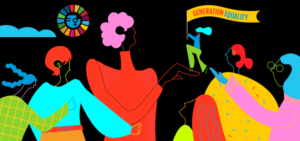The Sustainable Innovation Forum at COP21 hosted an abundance of growth companies that are interested in accelerating sustainable development and the advancement of the green economy. In developed countries, venture capital firms and governments are able to invest in these small companies in hopes that the firm can reap the reward of high returns. It is a rare occurrence for a VC firm to invest in a company in developing countries because of a lesser perceived value of human or economic capital in developing counterparts. Instead, developing countries receive billions of dollars a year of foreign aid in various forms–foreign direct investment, development aid and loans–from countries like the United States and the United Kingdom. Southeast Asia and Sub-Saharan Africa (receives $134 billion in foreign aid per year) are the largest beneficiaries of the funds, but are still amongst the poorest regions in the world. The numbers make it difficult to believe that so much aid does not foster development. Recent discussions around the effectiveness of international aid focus on the increasing importance of non-governmental organizations, or NGOs–approximately 90 percent of current NGOs have been launched after 1975. Globalization further evolves the role of NGOs to assist in transnational issues; as a result, NGOs have become the extension of political entities as they receive official government funding from entities like USAID and the World Bank. A problem arises from this new role because NGOs are accountable to their donor base, and it is more difficult to reconcile the goals of a private donor and a public donor. Moreover, a NGO’s legitimacy relies on its ability to act independently, and this independence is challenged when a NGO receives a large sum of public funds. NGOs play a unique role in the international aid community because they facilitate citizen engagement.
The pivotal role of NGOs is shown in 2000, when NGOs partnered with the United Nations, an intergovernmental organization, and its 189 member nations (now 193 member nations) to accomplish the Millennium Development Goals by 2015. The 8 MDGs were to (1) eradicate extreme poverty and hunger, (2) to achieve universal primary education, (3) to promote gender equality, (4) to reduce child mortality, (5) to improve maternal health, (6) to combat HIV/AIDS, malaria and other diseases, (7) to ensure environmental sustainability, and (8) to develop a global partnership for development. As it appears the MDGs were unsuccessful; a part of that can be attributed to the fact that the MDGs are broadly defined goals that are difficult to measure. Furthermore, the overall flow of aid into developing countries that was earmarked as a part of the MDGs appears to be at best “weakly associated with the rate of progress in MDG target areas” according to a paper for the UN’s High Level Panel on the Post-2015 Development Agenda. The lack of a direct correlation between the amount of aid provided and the results yielded indicates that resources could have been better allocated.
Perhaps under a different measurement scheme, a stronger correlation might have appeared, but universally NGOs tend to measure success by inputs of resources (monetary or otherwise) rather than the long term changes, and the social benefits, Admittedly, it would be difficult to measure the latter two, and it is bluntly evident from the activities of large NGOs, such as Red Cross, that NGOs are useful and necessary institutions in society. The use of NGO funds can engender a troubling attitude in the countries in which they are based because the NGOs are so active they sometimes encroach on the responsibilities of governments in the countries that they operate in. Instead of the government establishing education standards, proper healthcare systems or infrastructure, governments take a laissez-faire attitude because they assume that the NGOs will provide these resources. In this matter, we can see that there is a moral hazard, a term coined by 20th century American philosopher John Rawls. If the aid from NGOs funds basic needs for a country’s population that would typically be provided by its government, then it allows the government to spend irresponsibly with the knowledge that they will be bailed out by other countries and NGOs. This seems to be the case with MDG 8; the notion of more developed countries assisting less developed countries is well intentioned, but all it does is encourage governments to give more aid and foreign debt. It re-establishes the hierarchy that existed prior to the introduction of the MDGs.
Not all NGOs result in the realization of Rawls’ moral hazard. For example, BRAC (originally Bangladesh Rehabilitation Assistance Committee),founded in 1971 to help returning refugees after the Bangladesh Liberation War of 1971, has had great success in engaging and improving the communities that it is based in. After the NGO finished relief work, it turned to longer term development needs including village development programmes that included agriculture, fisheries, cooperatives, rural crafts, adult literacy, health and family planning, vocational training for women and construction of community centres. In the 1980s, BRAC sent volunteers to every household in Bangladesh to show mothers how to mix sugar, salt and water to rehydrate their children. BRAC also provided microcredit (small loans) to 5 million borrowers that total $725 million. The microcredit provided by BRAC is similar to Muhammad Yunus’ Grameen Bank. Grameen Bank only targets women, and provides $1 billion in loans to 8.4 million borrowers. Many argue that the borrowers end up worse off, but studies on Bangladesh show that following the use of microloans, poverty rates fell.
Microcredit provides loans to help people start businesses; these businesses use indigenous knowledge to innovate because the local knowledge is tangible. However, a lack of social networking amongst innovators in developing countries prevents innovators from faster collaborative learning. The capacity to use this indigenous knowledge to create technological innovations can drive social and economic development in developing countries. In order to make the transition from from local businesses to larger enterprises, additional funding (beyond microloans is needed). Microventure finance can bridge the missing gap and the grassroot innovations that are created by indigenous knowledge can generate employment and overcome poverty.
My personal appeal for the need of increased microventure finance in developing countries comes after a research trip to Bangladesh earlier this year. During the trip, we visited local villages to test arsenic levels in local wells. Many of the wells were put in by different NGOs, and, it was often the case that the wells installed in same villages were not identical. As a result, if one of the wells broke, knowledge on how to fix the wall was not easily transferable. The villagers, who we met, and Dhaka University students, who we travelled with, all had ideas how to fix the daily problems that they encountered. However, when asked why they did not make their solution a reality, they reverted that it was impossible and they did not even know where to begin. Moreover, many of the students were focused on getting jobs with large corporations following graduation. After this experience, I launched a start-up competition at Dhaka University to provide a small amount of risk capital and mentorship for the brave individuals who wanted to innovate. In many ways, some of the money and resources spent on aid could be provided as risk capital for innovators. By using resources to provide funding to knowledge rich, but economically poor individuals in local communities in developing countries, the ‘risk’ capital could generate a higher rate of return that just providing aid—where the economic rate of return is zero. This is not to say that the work and resources provided by NGOs is moot—there is a return as people’s lives are improved—but a re-allocation of capital could provide local innovators the opportunity to become entrepreneurs.
(Yassamin Issapour is founder of Harmony Ventures. She is a B.A in Economics & Sustainable Development Columbia University.)




